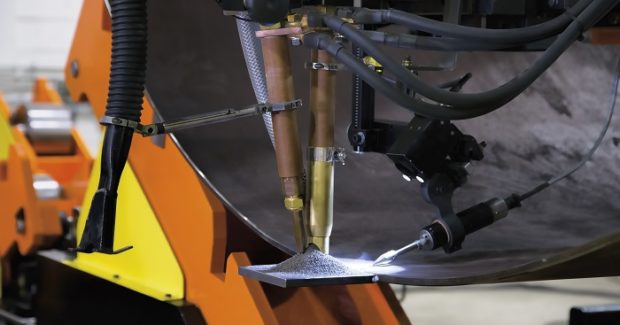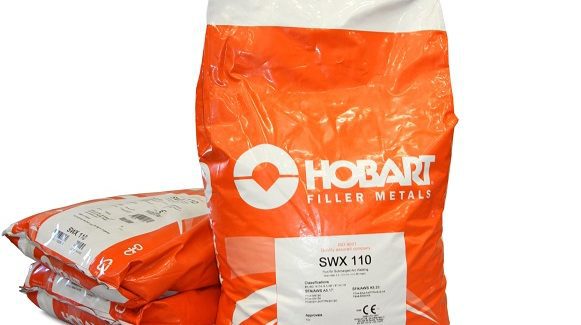How the Right Flux Unlocks the Full Potential of Submerged Arc Welding
A wide range of fluxes are available for the SAW process, including some that are specially formulated to bring specific properties and characteristics to the finished weld. With so many types of flux available, how do you know which option is the best choice for your application?
Posted: May 20, 2018
As critical factors to success in submerged arc welding (SAW), choosing the proper flux is just as important as selecting the right wire and equipment. The basic job of flux is to shield the weld pool from contamination. A wide range of fluxes are available for the SAW process, and some fluxes are specially formulated to bring specific properties and characteristics to the finished weld. With many types of flux available, how do you know which option is the best choice for your application? Review of these key considerations can help you make the choice and unlock the full potential of your SAW process.
THE ROLE OF FLUX
If you want best-in-class toughness or high travel speeds, the right flux can help achieve those goals. Choosing the optimal flux for your welding application is a key to maximizing performance. When selecting SAW flux, be sure to consider all variables in the welding operation, such as joint design, mechanical property requirements and productivity expectations. Then compare these factors with the unique characteristics of each flux. Among flux options, understanding key terminology used in product literature can help narrow down the right choice for the job. These include active flux versus neutral flux and high-basicity flux versus low-basicity flux.
ACTIVE OR NEUTRAL FLUX
Flux neutrality describes how much a flux can influence the chemical composition of the weld deposit. A flux is either active or neutral. As the name suggests, neutral fluxes remain neutral: they do not significantly influence the chemistry of the weld deposit. This is beneficial when making tough, crack-free multi-pass welds. Neutral fluxes have no limitations on material thickness, are not very parameter sensitive, and have minimal effect on the weld’s impact properties. Active fluxes can provide more unique welding characteristics because they actively influence weld chemistry. The additional manganese and silicon in active fluxes alloy the weld to compensate for high-dilution welds. Active fluxes are best suited for single- or two-pass fillet and groove welds and are typically not recommended for large multi-pass welds. Often, these fluxes improve weld cleaning, helping operators make quality welds on lightly rusted or scaled materials.
The formulas of many active fluxes also help to maintain good bead contour at high travel speeds. Keep in mind that active fluxes are very parameter sensitive, so it’s important to follow the manufacturer’s recommendations for operating parameters and to always maintain good control over the welding procedure. Also be aware that some welding codes limit or prohibit the use of active fluxes in certain applications. As a general rule, consider neutral fluxes for general purpose applications and active fluxes for fast one- or two-pass welds.
HIGH OR LOW BASICITY
Travel speed and productivity aren’t always the most important considerations in every welding application. One example of this is offshore structural fabrication, where welds need to resist harsh waves and storms and very low seawater temperatures while also helping to prevent environmental disaster. Weld toughness is critical in these applications. Toughness is the ability of a weld to absorb rapidly applied energy. When this is a primary design concern, consider a flux’s basicity. Basicity is the ratio of chemically basic to acidic compounds that make up the welding flux. Basicity is often expressed in terms of a Basicity index (Bi), which is a calculated value based on flux composition. In most cases, fluxes with higher basicity indexes offer improved toughness, while fluxes with lower basicity indexes typically offer more appealing welding characteristics, such as good weld bead appearance and easy slag removal.
It’s recommended to select fluxes with a high-basicity index for critical applications and demanding service conditions. But be aware that high-basicity fluxes weld much differently than low-basicity fluxes, typically producing a rougher bead appearance, less weld pool wetting action, and slag release that is somewhat more difficult. While fluxes with similar basicity index values tend to weld similarly, minute variations in flux composition can alter the way they weld. Selecting the best flux for your application is often a balancing act between mechanical properties, such as toughness, and operating characteristics, such as slag release. In most situations, a good rule of thumb is to select a flux with the lowest basicity that will still provide sufficient mechanical properties for the in-service weld.
PROPER USE AND STORAGE
In addition to choosing the right flux, proper use and storage of SAW flux also helps promote success. Any moisture in the flux contributes additional diffusible hydrogen into the weld metal, which can increase the risk of hydrogen-induced cracking. This risk is even greater when welding thick, restrained or high-strength materials. Look for flux that is formulated and packaged with low moisture content and take care to store it properly to reduce the chance of moisture absorption and, therefore, hydrogen-induced cracking. For example, most of our fluxes are heat-sealed in durable bags constructed to protect flux from moisture absorption, so the contents can be used directly from unopened packaging stored for up to three years without reconditioning. Once opened, fluxes should be stored in a heated drying cabinet or hopper at 255 deg F to 345 deg F.
If flux has been exposed to a moisture source, such as being outside of a heated hopper for a considerable amount of time, it’s necessary to recondition the flux by heating it in a drying cabinet at 570 deg F to 660 deg F for at least two hours. It’s important that the entire volume of flux (including the flux in the middle of a container) reaches this temperature, otherwise the average moisture level may still be higher than recommended. To maintain good welding characteristics, reconditioning should not be performed on SAW flux more than twice.
A CRITICAL COMPONENT
Submerged arc welding flux does much more than simply protect the weld. The right flux can help give you the best balance of properties and performance for optimized results. Always consider the wire and flux combination for any application, no matter how simple or complex. A filler metal manufacturer can also provide suggestions and help you choose and implement the best solutions.











